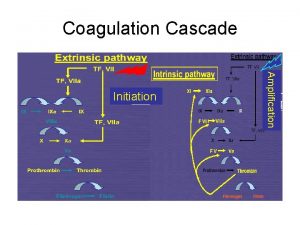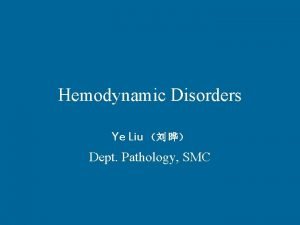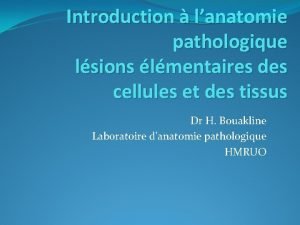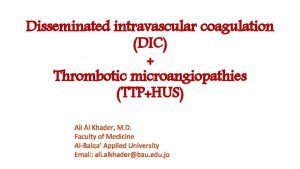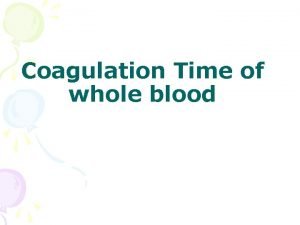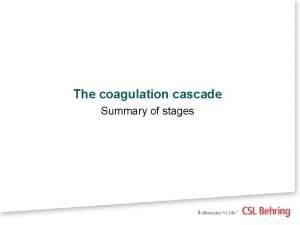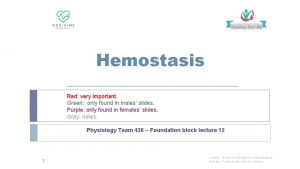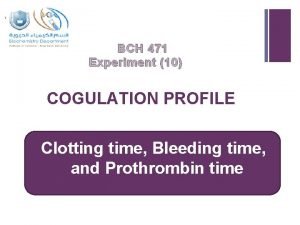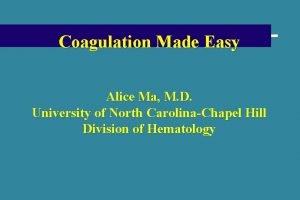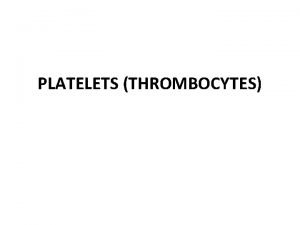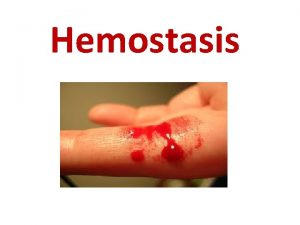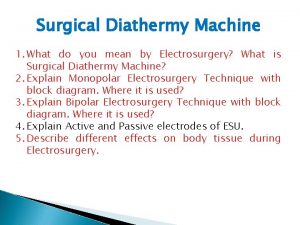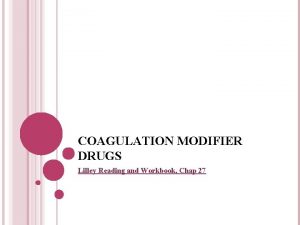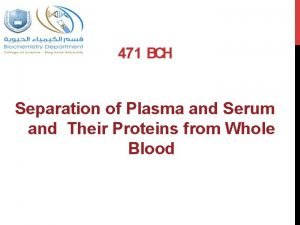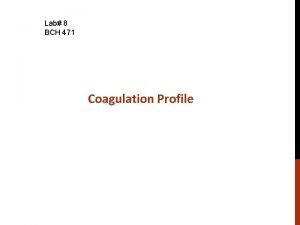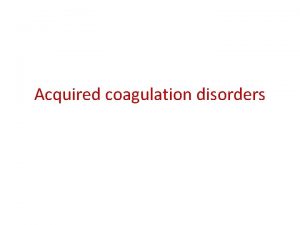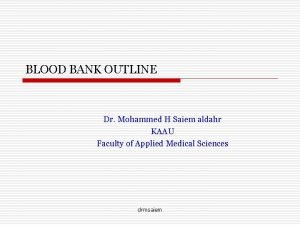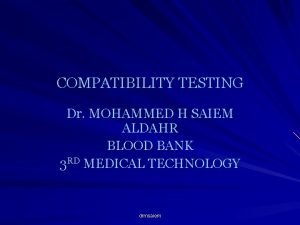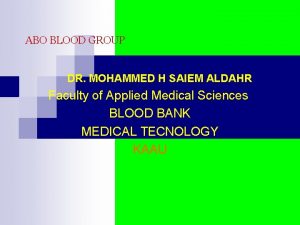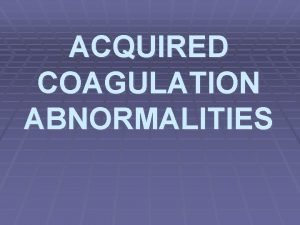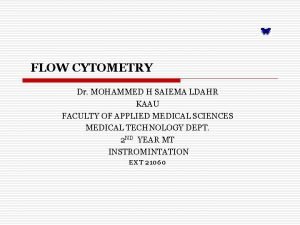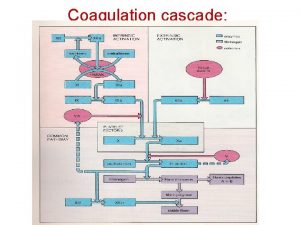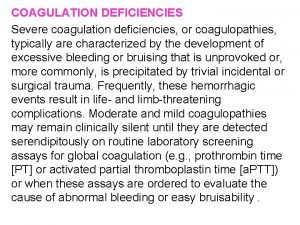Acquired Coagulation Disorders Dr Mohammed Saiem Aldahr KAAU

















- Slides: 17

Acquired Coagulation Disorders Dr Mohammed Saiem Al-dahr KAAU Faculty of Applied Medical Sciences dr msaiem

Acquired coagulation disorders n n n q n n n Objectives Following this lecture, the student will be able to Explain the classification of acquired disorder of haemostasis such as: Hepatic disease, vitamin K deficiency, renal disease, Explain the action of oral anticoagulants Name the most common laboratory tests used to monitor oral anticoagulant therapy List mechanisms and clinical conditions associated with DIC. Define three generalized clinical states of DIC Laboratory abnormalities associated with DIC. Identify therapies for treatment of DIC dr msaiem

Acquired coagulation disorders n n n The normal haemostasis is a normal balance carefully designed so that hemorrhage arrested and inappropriate thrombosis does not occur. Acquired disorders of haemostasis occur with many, systemic diseases, drugs, physical states pregnancy and newborns. Diagnosis depends on; Careful history Physical Examination Properly directed lab tests. dr msaiem

Acquired coagulation disorders n The initial difficulty is to distinguish local bleeding e. g. peptic ulcer from systemic disease. n An initial series of screening tests are performed easily and rapidly; Platelet count + Blood film Bleeding time (BT) Prothrombin Time (PT) Partial Thromboplastin Time (PTT) Thrombin Time (TT) Assessment of Fibrinogen n n n dr msaiem

Acquired coagulation disorders n If screening is suggestive, specific special investigations are performed to confirm, the diagnosis. n The acquired disorders of haemostasis that will be discussed here include the following; Hepatic Disease Vitamin K deficiency Vitamin K Antagonists Renal Disease DIC n n n dr msaiem

Acquired Coagulation Disorders n Hepatic Disease The liver is the principal site of synthesis of procoagulant, fibrinolytic, and coagulation inhibitory proteins. n Liver disorders present two challenges: 1 -Decreased synthesis of coagulation, lysis and inhibitory proteins 2 -Impaired clearance of activated haemostatic components. n The type of disorder differs in neonates and adults. dr msaiem

Acquired coagulation disorders n Neonates display decreased levels of plasma contact factors secondary to hepatic immaturity. n They also lack sufficient levels of Plasminogen and anti. Thrombin III. n Neonates express a unique fetal fibrinogen that does not behave in the same manner as adult fibrinogen, and they have decreased of fibrinogen. dr msaiem

Acquired coagulation disorders n In adults, liver diseases, such as cirrhosis, hepatitis, and diseases that infiltrate liver tissue, such as neoplasm, affect the synthetic capacity of the liver. n Prolongation of the PT is considered a sign of worsening disease because of depression vitamin K-dependent factor synthesis, poor dietary intake or mal-absorption of vitamin K. n Fibrinolytic events and thrombocytopenia may accompany liver disease. dr msaiem

Acquired Coagulation Disorders n n Laboratory Findings Screening tests such as the PT, APTT, bleeding Time, platelet count, fibrinogen levels, and FDP determinations are used to monitor haemostatic status in liver disease patients. Therapy Infusion of fresh plasma may increase the circulating levels of pro-coagulants and minimize the hemorrhagic risk. dr msaiem

Acquired coagulation disorders n Vitamin K Deficiency For coagulation factors (II, VII, IX, and X) to become active they have to bind Calcium. This is preceded by carboxylation which is mediated by Vitamin K n Vitamin K Is fat soluble vitamin, stored in the liver in small amounts so can be depleted in 2 -3 days n Patients with depleted vitamin K or on K antagonists cannot carboxylate these coagulation factors. dr msaiem

Acquired coagulation disorders n n Vitamin K is necessary co-factor for the conversion of terminal glutamic acid residues to gammacarboxyglutamic acid on factors II, VII, IX, X, as well as on protein C & S This conversion takes place in the hepatocyte and is necessary for proper function. Laboratory finding. n PT prolonged n PTT prolonged n Functional assays of vitamin K factors show level dr msaiem

Acquired coagulation disorders Vitamin K Antagonists Oral anticoagulants Mechanism of Action n All the vita K-dependent coagulation proteins, (F II, VII, IX, X, proteins S and C) are characterized in their structure by specific chain where some glutamic acid residues undergo a gamma-carboxylation. n This gamma-carboxylation is vitamin K-dependent. The presence of carboxylated groups is necessary for the binding of Ca ions required for the formation of the various activation complexes during the activation of the coagulation. n dr msaiem

Acquired coagulation disorders dr msaiem

Acquired coagulation disorders n The classic oral anticoagulant (Warfarin) presents a structural similarity with vitamin K n Therefore, these anticoagulant are able to inhibit the regeneration step of reduced vitamin K. n The inhibition of the reduced vitamin K by anticoagulants blocks the final synthesis step of these vitamin K dependent proteins. dr msaiem

Acquired coagulation disorders n n n Laboratory The most common laboratory test to monitor oral anticoagulant therapy is the PT It is sensitive to the decrease of factors II, VII, X. PT does not reflect the effect of the drug on factor IX. To promote standardization of the PT for monitoring oral anticoagulant therapy, HWO has developed an international reference thromboplastin from human brain tissue and has recommended that the PT ratio expressed as the International Normalized Ratio (INR). INR value for a plasma depends on the international sensitivity index (ISI). dr msaiem

Acquired coagulation disorders Renal Disease. n In acute and chronic renal diseases there is often bleeding tendency associated several haemostatic abnormalities. n Thrombocytopenia frequently develop in uremia Vitamin K deficiency due to malnutrition, associated liver disease with factor V deficiency. n dr msaiem

Acquired coagulation disorders n Isolated factors IX and XII deficiency were reported in nephrotic syndrome n excessive loss of these proteins in the urine. Antithrombin III and plasminogen are also lost in nephrotic syndrome through increased urinary loss. n Patients with renal disease commonly have: n A prolonged bleeding time (BT) n Prolonged PT and PTT n Low platelet count n Anemia dr msaiem
 Coagulation disorders
Coagulation disorders Denaturation simple definition
Denaturation simple definition Nutmeg liver
Nutmeg liver Dégénérescence hydropique
Dégénérescence hydropique Disseminated intravascular coagulation
Disseminated intravascular coagulation Composition of eggs
Composition of eggs Clotting time procedure slide method
Clotting time procedure slide method Loading or coagulation
Loading or coagulation Coagulation cascade
Coagulation cascade Ecchumosis
Ecchumosis Coagulation profile test
Coagulation profile test Coagulation pathway made easy
Coagulation pathway made easy Dicoumoral
Dicoumoral 13 blood clotting factors list pdf
13 blood clotting factors list pdf Parts of a diathermy machine
Parts of a diathermy machine Dvt workbook
Dvt workbook Plasma and serum
Plasma and serum Coagulation profile test
Coagulation profile test
